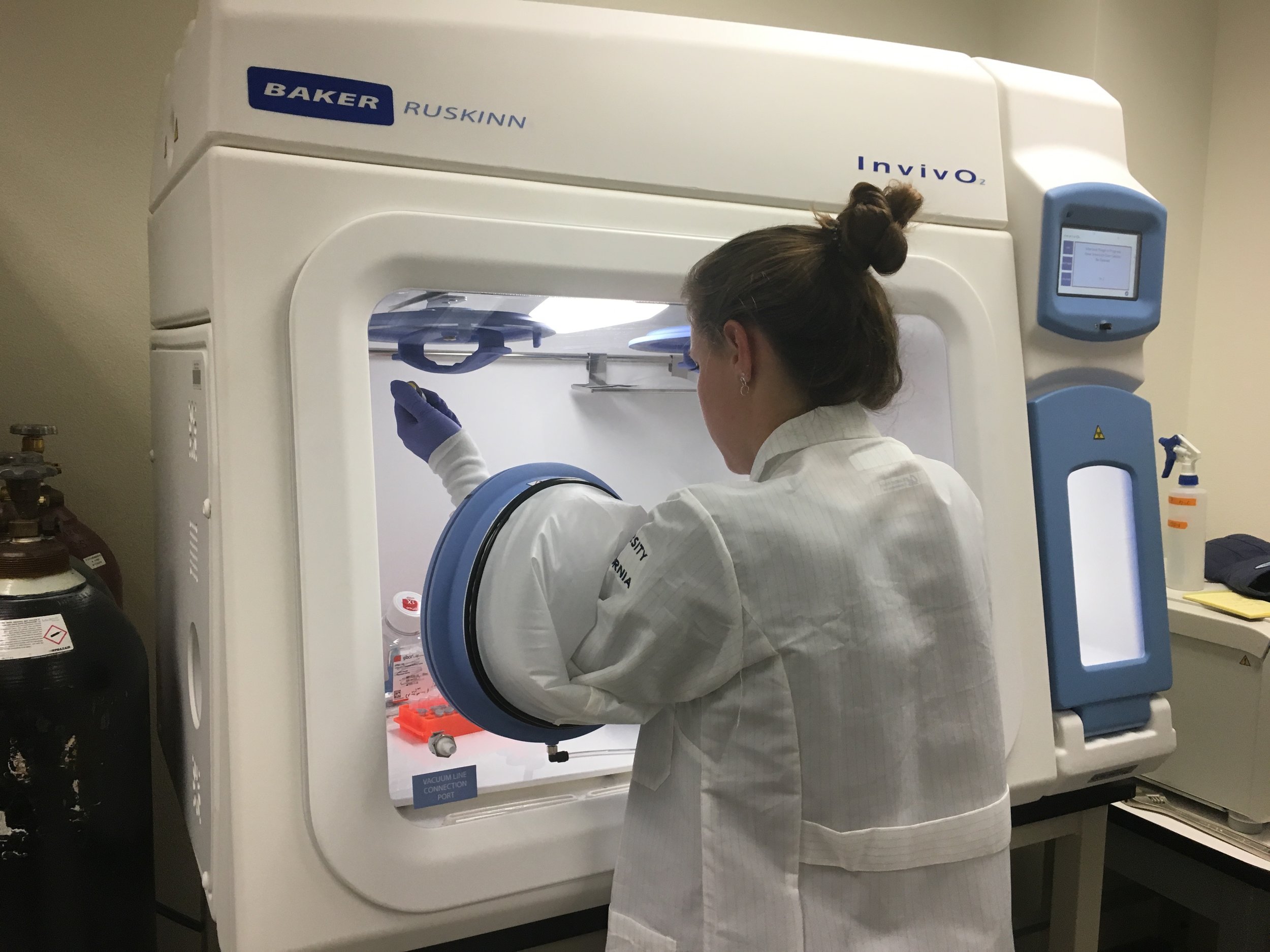Project Overview
We study physiological adaptations to natural and anthropogenic stressors in marine vertebrates and the role of oxidative stress and redox signaling in pre-clinical models of disease at the molecular, cellular, and organismal levels. Our overarching goal is to understand the physiological mechanisms that drive extreme adaptation in marine vertebrates and the contributions of redox biology to the progression of several diseases. Current projects in our lab include 1) chronic stress responses in marine vertebrates, 2) cellular and molecular mechanisms underlying hypoxia tolerance in diving vertebrates, 3) the role of peroxiredoxin 6 in inflammatory disease, and 4) redox signaling in aging and metabolic syndrome.
Elephant seal dermal fibroblasts expressing GFP
Stress Physiology
We are studying the physiological consequences of exposure to natural and anthropogenic stressors in marine vertebrates using a combination of primary tissue culture models (myoblasts, fibroblasts, adipose-derived mesenchymal stem cells) derived from pinnipeds, cetaceans, and sea turtles and whole animal experiments with elephant seals and other marine vertebrates. These studies are a collaboration with several colleagues, including Dan Crocker (Sonoma State University), Tania Zenteno (CIBNOR, Mexico), Jorge Urban (UABCS, Mexico), Peter Sudmant (UC Berkeley), Jane Khudyakov (University of the Pacific), and Anders Goksøyr (University of Bergen). This work is supported by UC MEXUS, the Peder Sather Center, and the Norwegian Research Council among others.
Selected publications:
Arango BG, Ensminger DC, Moreno-Santillán DD, Harfush-Meléndez M, López-Reyes EM, Marmolejo-Valencia JA, Merchant-Larios H, Crocker DE, Vázquez-Medina JP. 2022. Oxidative stress is a potential cost of synchronous nesting in olive ridley sea turtles. Antioxidants, 11, 1772. PMID: 36139846
Torres-Velarde JM, Kolora SRR, Khudyakov JI, Crocker DE, Sudmant PH, Vázquez-Medina JP. 2021. Elephant seal muscle cells adapt to sustained glucocorticoid exposure by shifting their metabolic phenotype. Am. J. Physiol. Regul. Integr. Comp. Physiol. 321: R413–R428. PMID: 34260302
Ensminger DC, Crocker DE, Lam EK, Allen KN, Vázquez-Medina JP. 2021 Repeated stimulation of the HPA axis alters white blood cell counts without increasing oxidative stress or inflammatory cytokines in fasting elephant seal pups. J. Exp. Biol. 224, jeb243198. PMID: 34524449
Lam EK, Allen KN, Torres-Velarde JM, Vázquez-Medina JP. 2020. Functional studies with primary cells provide a system for genome-to-phenome investigations in marine mammals. Integr. Comp. Biol. icaa065. PMID: 32516367
Catalytic sites of Prdx6
Peroxiredoxin 6
Peroxiredoxin 6 (Prdx6) is an enzyme that has two separate catalytic sites and expresses at least two different activities: glutathione peroxidase and phospholipase A2. We are using knock-in mice models with single-point mutations that inactivate each of the Prdx6 activities alone to study the contributions of this enzyme to the prevention of oxidative damage and cell death and the maintenance of mitochondrial function. This work is supported by the National Institute of General Medical Sciences (Award Number R35GM146951).
Selected publications:
Torres-Velarde JM, Allen KN, Salvador-Pascual A, Leija RG, Loung D, Moreno-Santillán DD, Ensminger DC, Vázquez-Medina JP. 2024. Peroxiredoxin 6 suppresses ferroptosis in lung endothelial cells. Free Radic. Biol. Med. 218, 82-93. PMID: 38579937
Vázquez-Medina JP, Tao, JQ, Patel P, Bannitz Fernandes R, Dodia C, Sorokina E, Feinstein SI, Chatterjee S, Fisher AB. 2019. Genetic inactivation of the phospholipase A2 activity of peroxiredoxin 6 protects against LPS-induced acute lung injury. Am. J. Physiol. Lung Cell. Mol. Physiol. 316: L656–L668. PMID: 30702344
Arevalo JA, Vázquez-Medina JP. 2018. The role of peroxiredoxin 6 in cell signaling. Antioxidants 7, 172. PMID: 30477202
Physiological hypoxia station
Hypoxia and oxidative stress tolerance
Seal tissues are routinely exposed to hypoxia/reoxygenation due to the cardiovascular adjustments associated with diving. Since this is a natural behavior, seals don't suffer from the classic complications observed after those events in humans (stroke, heart attacks, embolism). We are studying the cellular and molecular mechanisms that drive tolerance to hypoxia/reoxygenation and oxidant stress in seals using an ex vivo model of flow-adapted seal endothelial cells cultured under controlled oxygen conditions and in vivo experiments. Collaborators on this project include Allyson Hindle (UNLV), Celine Godard (Texas Tech), Peter Sudmant (UC Berkeley), and James Olzmann (UC Berkeley). This work is supported by the National Science Foundation, Office of Polar Programs (Award Number 2020664), the Winkler Family Foundation, and the National Institute on Aging (Award Number R21AG084993).
Selected publications:
Allen KN, Torres-Velarde JM, Vazquez JM, Moreno-Santillán DD, Sudmant PH, Vázquez-Medina JP. 2024. Hypoxia blunts angiogenic signaling and upregulates the antioxidant system in elephant seal endothelial cells. BMC Biology 23:91. PMID: 38654271
Allen KN, Vázquez-Medina JP. 2019. Natural tolerance to Ischemia and hypoxemia in diving mammals: a review. Time Domains of Hypoxia Adaptation: Evolutionary Insights and Applications Research Topic. Front. Physiol., Integrative Physiology, 10, 1199. PMID: 31620019
White adipose tissue sections from lean and obese (OLETF) rats stained with perilipin.
Redox signaling in aging and metabolic disease
In collaboration with George Brooks (UC Berkeley), Rudy Ortiz (UC Merced) and Rosh Rahimian (University of the Pacific) we are studying the role of redox signaling and mitochondrial dysfunction in aging and metabolic disease. We use a combination of primary cell systems, aged mice, and rodent models of metabolic syndrome syndrome (OLETF and UCDT2DM rats) to conduct our studies. This work is supported in part by the National Institute on Aging (Award Number R01AG059715).



